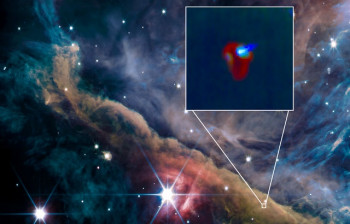News
Radiation from massive stars shapes planetary systems
Faculty of Science and EngineeringCentre for Fundamental Physics
29 February 2024
Astronomers have discovered a unique planetary system where a young star is being stripped bare of its planet-forming material at an astonishing rate.
This unprecedented observation, published in the Science and featured on its cover, provides a crucial clue to understanding the diverse and puzzling worlds beyond our solar system.
For decades, astronomers have known that the powerful light emitted by massive stars can disrupt the swirling disk of dust and gas around young stars, the very cradle from which planets are born. But a crucial question remained unanswered: how quickly does this process occur, and does it leave enough material to form planets?
This new research, led by Dr. Oliver Berné at CNRS, France, and involving Dr. Thomas Haworth from Queen Mary University of London, offers an answer. Utilising the powerful James Webb Space Telescope, they studied a stellar nursery, the Orion Nebula, specifically a protoplanetary disc named d203-506, where the planet-forming material, normally confined to a tiny region, has been blown up to an unusually large size. This allowed them to measure the rate of material loss with unprecedented accuracy.
"This is a truly exceptional case study," says Dr Haworth. "The results are stark: the young star is losing a staggering 20 Earth masses of material per year, suggesting that no Jupiter-like planets could possibly form in this system. The rate we measured aligns perfectly with our theoretical models, giving us confidence to understand how different environments shape planet formation across the universe."
He goes onto explain why this case is so special: "Unlike other known cases, this young star is only exposed to one type of UV radiation from the nearby massive star. The lack of a "hot cocoon" created by the more energetic UV radiation allows the planet-forming material to become much larger and easier to study."
This discovery adds a crucial piece to the puzzle of planetary diversity. With over 5,500 planets now known beyond our solar system, astronomers are struggling to understand why they come in such a wide variety of sizes and compositions. This research suggests that the environment around a young star plays a critical role in shaping the planets that form.
Dr Haworth, who has received over £3 million in funding to explore the mysteries of planet formation, explains, "This research helps us piece together the puzzle of how stellar environments sculpt planetary systems. By understanding the factors at play, we can better understand the vast spectrum of planets out there, gain a deeper understanding of our own place in the cosmos, and even predict where to find Earth-like worlds."
Updated by: David Lockwood


